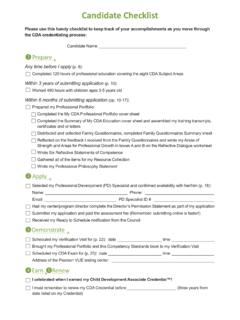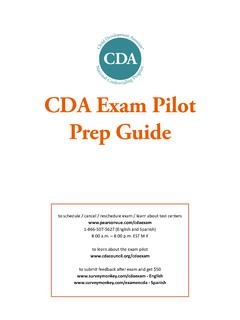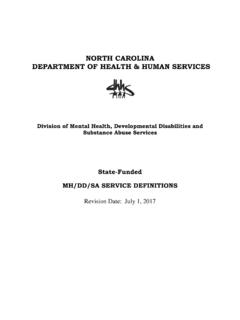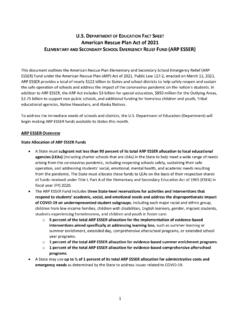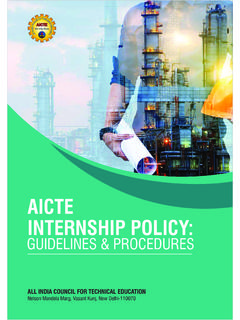Transcription of Suggested Relationship Between the CDA Formal Child Care ...
1 Suggested Relationship Between the CDA Formal Child Care Education Requirement and NAEYC Standards for professional Preparation Programs This document is offered as a guide to correlate the Formal education learning experiences aligned with defined learning outcomes, and a requirements of the Council for professional Recognition (the Council) system of assessments that ensure program completers have mastered as part of earning a CDA credential and the 2009 National Association those defined learning outcomes and can demonstrate them in practice. for the Education of Young Children (NAEYC) Standards for In training and education programs for the early childhood workforce, professional Preparation Programs.
2 Desired learning outcomes include the NAEYC professional Preparation Standards and the CDA Competencies. The following chart is more than a checklist of topics to cover or information to transmit through presentations, activities, textbooks or It is in support of this concept that the Council requires CDA. handouts. It is intended as a contribution to a larger discussion about Candidates to participate in 120 clock hours of Formal education in what early childhood professionals should know and be able to do - the specific areas - no fewer than 10 hours in each subject area and a total importance and quality of professional training and education, the of 120 clock hours.
3 Similarly, only full programs of study and not decisions that are made when designing and evaluating training and individual workshops or courses are eligible for NAEYC accreditation education programs, and exploration of related issues such as the though the common core NAEYC standards have differing initial . portability of individual credentials and the desired professional and advanced expectations in associate, bachelor, master, and continuum or pathway from entry into the early childhood field to doctoral degree programs. advanced or specialized credentials earned over the course of a career. NAEYC and the Council are advocates for state and national Research and common sense indicate that the expertise needed to professional development systems that help personnel make provide a nurturing environment for young children is acquired connections Between the information they learn in the first hour of through specialized professional development - training, education and training and the 120th hour; Between their first course and completion technical assistance that begins with entry into the field and continues of a specialized degree.
4 Between what they learn in one content area throughout each individual career. Effective professional development and another; Between theory and practice; Between who they are today is grounded in relationships, theory and practice, and results in and who they will be in the future. NAEYC standards provide a meaningful connections. It transforms discrete learning experiences common national framework for all early childhood professional into an integrated body of knowledge, dispositions and skills. development systems and programs. The CDA is a key stepping stone on the path of career advancement in early childhood education.
5 professional development takes place in many forms, but where it is most effective, there is an organized process, a coherent sequence of NAEYC and Council for professional Recognition February 2012. NAEYC STANDARDS CDA SUBJECT AREAS. I. Promoting Child development and learning Subject Area 1: Planning a safe, healthy learning environment Students prepared in early childhood degree programs are grounded in a Child development Safety, first aid, health, nutrition, space planning, materials and equipment, play knowledge base. They use their understanding of young children's characteristics and needs and of the multiple interacting influences on children's development and learning to create environments that are Subject Area 8: Understanding principles of Child development and learning healthy, respectful, supportive, and challenging for each Child .
6 Typical developmental expectations for children from birth through age 5, individual variation including children with special needs, cultural influences on development 2. Building family and community relationships Subject Area 4: Building productive relationships with families Students prepared in early childhood degree programs understand that successful early childhood Parent involvement, home visits, conferences, referrals, communication strategies education depends on partnerships with children's families and communities. They know about, understand, and value the importance and complex characteristics of children's families and communities.
7 They use this understanding to create respectful, reciprocal relationships that support and empower families and to involve all families in their children's development and learning. 3. Observing, documenting, and assessing Subject Area 7: Observing and recording children's behavior Students prepared in early childhood degree programs understand that Child observation, Tools and strategies for objective observation and assessment of children's behavior documentation, and other forms of assessment are central to the practice of all early childhood and learning to plan curriculum and individualize teaching, developmental delays, professionals.
8 They know about and understand the goals, benefits, and uses of assessment. They intervention strategies, individual education plans know about and use systematic observations, documentation, and other effective assessment strategies in a responsible way, in partnership with families and other professionals, to positively influence the development of every Child . 4. Using developmentally effective approaches to connect with children and families Subject Area 2: Advancing children's physical and intellectual development Students prepared in early childhood degree programs understand that teaching and learning with Large and small muscle, language and literacy, discovery, art, music, mathematics, young children is a complex enterprise, and its details vary depending on children's ages, social studies, science, technology, and dual language learning characteristics, and the settings within which teaching and learning occur.
9 They understand and use positive relationships and supportive interactions as the foundation for their work with young children Subject Area 3: Supporting children's social and emotional development and families. Students know, understand, and use a wide array of developmentally appropriate ap- Adult modeling, self-esteem, self-regulation, socialization cultural identity, conflict proaches, instructional strategies, and tools to connect with children and families and positively resolution influence each Child 's development and learning. 5. Using content knowledge to build meaningful curriculum Subject Areas 2 & 3 provide an introduction to the essential concepts, inquiry tools Students prepared in early childhood degree programs use their knowledge of academic disciplines to and structures of the academic content disciplines that are part of an early childhood design, implement, and evaluate experiences that promote positive development and learning for each curriculum.
10 However, the Child development Associate is not expected to design or and every young Child . Students understand the importance of developmental domains and academic NAEYC and Council for professional Recognition February 2012. (or content) disciplines in early childhood curricula. They know the essential concepts, inquiry tools, evaluate curriculum. and structure of content areas, including academic subjects, and can identify resources to deepen their understanding. Students use their own knowledge and other resources to design, implement, and evaluate meaningful , challenging curricula that promote comprehensive developmental and learning outcomes for every young Child .


